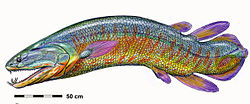| Brachiopods of the Gravel Point Formation |
|---|
| Genus | Species | Presence | Material | Notes | Images |
|---|
| Atrypa | A. corrugata | | [1] | | |
| Douvillina | D. sp. | Lower part of the formation. [3] | 2 specimens. [3] | | |
| Heteralosia | H. sp. B | | 2 pedicle valves. [3] | | |
| Leptalosia | L. radicans | | [3] | Also found in the Norway Point, Alpena, Four Mile Dam, Genshaw, Arkona and Hungry Hollow formations. | |
| Longispina | L. emmetensis | | [3] | Also found in the Alpena Limestone and Four Mile Dam Formation. | |
| Mucrospirifer | M. latus | | [1] | A spiriferid. | |
| M. sp. | | [1] | A spiriferid. | |
| Oligorhachis | O. oligorhachis | | [3] | Also found in the Four Mile Dam Formation. | |
| Orthopleura | O. sp. A | "Large Atrypa zone". [3] | One specimen (U.S.N.M. no. 124258). [3] | | |
| O. sp. B | "Upper Blue shale". [3] | One specimen (U.S.N.M. no. 124280). [3] | | |
| Pentamerella | P. aftonensis | Gorbut Member. [3] | | | |
| P. alpenensis | | [3] | Also found in the Alpena Limestone and Four Mile Dam Formation. | |
| P. sp. D | | A small collection of large shells (the largest being 38 millimeters). [3] | | |
| Pholidostrophia | P. geniculata | | [3] | Also found in the Alpena, Widder and Hungry Hollow formations. | |
| Pseudoatrypa | P. keslingi | | [1] | | |
| Schuchertella | S. anomala | | [3] | Possibly also found in the Four Mile Dam Formation. | |
| Strophodonta | S. costata | | [1] | A strophomenid. | |
| S. cf. S. erotica | | [1] | A strophomenid. | |
| S. erratica | | [3] | Also found in the Alpena Limestone and Four Mile Dam Formation. | |
| S. fissicosta | Upper part of the formation. [3] | | Also found in the Four Mile Dam Formation. | |
| S. nanus | | [3] | Also found in the Alpena Limestone and Four Mile Dam Formation. | |
| S. titan titan | | [3] | Also known from the Alpena Limestone. | |
| Truncalosia | T. gibbosa | | [3] | Also found in the Alpena, Genshaw, Norway Point, Petoskey and Potter Farm formations, the Arkona Shale and the Hamilton Group. | |
| Tylothyris | T. subvaricosa | | [4] | Also found in the Cedar Valley, Milwaukee, Mineola, Bell, Rockport Quarry, Ferron Point, Genshaw, Alpena, Norway Point and Potter Farm formations. | |




